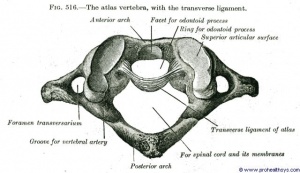Transverse Ligament Stress Test
Be the first to edit this page and have your name permanently included as the original editor, see the editing pages tutorial for help.
|
Original Editor - Your name will be added here if you are the original editor on this page. Lead Editors - Your name will be added here if you are a lead editor on this page. Read more. |
Purpose
[edit | edit source]
Test for hypermobility of the atlantoaxial articulation.
Technique [1][edit | edit source]
- The patient is placed in a supine postion with the Therapist supporting the patient's head with the palms and 3rd-5th fingers.
- The Therapist then places the index fingers between the occiput and spinous process of C2, so the index fingers are over the neural arch of the C1 vetebra.
- The Therapist then lifts the patients head and C1 vetebra anteriorly, without allowing flexion or extension.
- The position should be held for 10-20 seconds.
- A positive test is the reoccurance of symptoms.
| [2] |
Evidence[edit | edit source]
Provide the evidence for this technique here
Resources[edit | edit source]
Pettman E: Stress tests of the craniovertebral joints. In: Boyling, JD, Palastanga N, eds. Grieve's Modern Manual Therapy: The Vertebral Column, 2nd edn. Edinburgh: Churchill Lingstone, 1994:529-538.
References
[edit | edit source]
- ↑ ↑ Dutton, M. (2008). Orthopaedic: Examination, evaluation, and intervention (2nd ed.). New York: The McGraw-Hill Companies, Inc.
- ↑ online video,http://www.youtube.com/watch?v=GN-yvAYFIig, last accessed 06/04/09







